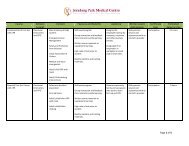Diagnostic Imaging - Jerudong Park Medical Centre
Diagnostic Imaging - Jerudong Park Medical Centre
Diagnostic Imaging - Jerudong Park Medical Centre
You also want an ePaper? Increase the reach of your titles
YUMPU automatically turns print PDFs into web optimized ePapers that Google loves.
Preparation for the procedureThe patient is usually asked to fast 3-4 hours beforethe CT examination in case intravenous contrastneeds to be injected to facilitate a clearer view ofthe organs being studied. The contrast is acolourless, non-ionic agent fluid, which is injectedvia a vein (arm or leg). This may cause a warm orflushed sensation. Oral contrast agent may also beadministered, especially for abdomen and pelvicscans.If contrast agents are required, the patient willbe briefed and any allergies to food or medicinewill be ascertained. Prescribed medication may beadministered but insulin treatment for diabeticsshould be delayed until the patient resumes foodconsumption in order to avoid an insulin reaction.The patient will also change into a hospital gownand remove items such as glasses, jewellery, denturesand hearing aids etc, which interfere with the x-ray.After the CT ExaminationFollowing the CT examination, the patient is requiredto stay on the CT table until the radiographer confirmsthe necessary examination has been obtained. Thepatient can then return to the ward or home.Unless there are other scans scheduled, the patientmay eat normal food and should drink plenty offluid to eliminate any contrast agent from the body.Are there any risks with CT Scanning?CT scanning is a medical imaging procedureperformed to gain further information about apatient’s illness. The risk from medical x-rayexaminations, if it exists at all, is extremely small.The benefits far outweigh the risk.If there are any further queries, please do not hesitateto contact the Radiologist or Radiographer.Types of CT Scan ImagesIsotropic VolumeAcquisition & Multi-planarReconstructionIn older scanners, reconstructionin any plane, except the axialplane, resulted in degradationof the image. In the 64-sliceCT scanner with isotropicvolume acquisition and multi-planar reconstructionimages in any plane are of the same quality.Organs and pathology can be viewed from multiplediretions to improve diagnostic accuracy.3D <strong>Imaging</strong> and VolumeRenderingIn the 64-slice Scanner,volume rendering allowstissue layers to be strippedaway to show the areas ofinterest. The resultant image canbe viewed in either 2D or 3Dand in their natural anatomical colour. Withreal-timemulti-planar imaging (MPR), the radiologist can viewthe images in any plane instantaneously.Vascular <strong>Imaging</strong>Head to toe images ofthe arterial system, in colour and3D are performed followingintravenous injection ofcontrast. Arterial catheterisationis no longer necessary. Thisallows precise pre-operativeexamination of vascular disease and accuratepreoperative assessment for stenting procedures.20 • Radiology Multi-Slice (64-slice) CT Scanning Radiology Multi-Slice (64-slice) CT Scanning• 21













